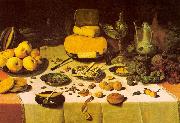Wholesale Oil Painting No Minimum |
|||||||||||
|
|
|||||||||||

|
|||||||||||
|
|
|
||||||||
Floris van DijckDutch Baroque Era Painter, 1575-1651 Dutch painter and draughtsman. He is thought to have been a pupil of Rembrandt in Amsterdam c. 1650. There is no documentary evidence for this, but his earliest dated painting, the Presentation in the Temple shows that he had certainly seen examples of Rembrandt work. He was an eclectic artist, given to following several models simultaneously. This is evident from two versions of Elijah and the Widow of Zarephath; one (1655-60; Copenhagen, Stat. Mus. Kst) is painted in horizontal format in the style of Barent Fabritius, while the other (1655-60; Milwaukee, WI, A. Bader priv. col., see Sumowski, 1983, no. 362) features large half-length figures in the manner of Nicolaes Maes. In another biblical scene, Benjamin and Judah (1655-60; Chicago, IL, A. Inst.), he followed the example of Rembrandt. His best works, such as Saying Grace (1655-60; Hannover, Nieders?chs. Landesmus.) and the Old Prophetess (1655-60; Leipzig, Mus. Bild. Kst), show old women either praying or sleeping and confirm that Maes was his main source of inspiration. Similar subjects are represented in the drawings attributed to him (e.g. Old Woman Seated, Holding a Book; New York, Pierpont Morgan Lib.). In the late 1650s van Dijck also seems to have been influenced by the genre paintings of Gabriel Metsu and above all by Quiringh van Brekelenkam, as in Hermit Praying in a Cave (late 1650s; St Petersburg, Hermitage) and Family Saying Grace (late 1650s; Stockholm, Nmus.). |
||||||||
|
|
||||||||
Laid Table
Laid Table Painting ID:: 973 |
1622 1622 |
|||||||
|
CONTACT US |

